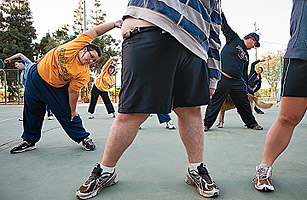
Elizabeth Fedorchalk was tired of being fat. She had been trying to lose weight since elementary school, but diets never made a difference. She wasn’t husky. She wasn’t big-boned. By age 16, the 5-ft. 5-in., 291-lb. high school junior from Holts Summit, Mo., was undeniably obese. And each year, it was only getting worse. Fedorchalk’s diet was abysmal. She skipped breakfast, ate lunch at school — usually chicken strips and fries — and frequently had dinner at McDonald’s: a burger and more fries. She drank nondiet soda and snacked on potato chips and Little Debbie cakes. She never exercised because, between school and extracurricular activities, she claimed she didn’t have time. “It got to where I didn’t like sports anymore,” Fedorchalk says. “I’d get out of breath and get upset because mentally I wanted to do so much, but physically I couldn’t.” She gained 45 lb. in 2009 alone. She had high cholesterol, and her weight put her at risk for hypertension, heart disease, sleep apnea and Type 2 diabetes. By any measure, Fedorchalk was in poor health. But look around. She is hardly alone. In the past 30 years, obesity rates among U.S. children have more than tripled. A flurry of antiobesity legislation has taken aim at environmental factors that have contributed to the epidemic, and Michelle Obama’s sweeping new Let’s Move campaign to end childhood obesity will most likely inspire further changes in the coming years. But while healthier school lunches and public-service announcements may help future generations stay fit, they won’t make someone like Fedorchalk thin. Our national dialogue focuses on obesity prevention, but what do we do for kids who have already gained the weight? As Fedorchalk’s weight climbed, her parents feared for her well-being. “We couldn’t communicate with her or get her to change her habits,” says her mother Michele. Family members decided there was nothing they could do for her at home; she needed professional help. In September, they sent her to Wellspring Academy, a residential weight-loss facility in Reedley, Calif. For families like the Fedorchalks, Wellspring offers a commodity often in short supply: hope. But turning that hope into a long-term remedy for teen obesity isn’t easy. Weight-Loss Boarding SchoolWhen marathon runner and educator Ryan Craig opened Wellspring Academy in 2004, it was the only residential obesity-treatment center of its kind. A former board member of the Aspen Education Group — one organization behind those wilderness programs for troubled teens — Craig learned about the staggering U.S. obesity rates and saw an enormous untapped market for a weight-loss school. Wellspring Academy houses about 75 students in grades 8 through 12, all at various stages of weight loss. Students can enroll at any time and must stay at least four months. They live together in dorms, just like at traditional boarding schools. Aside from regular academic classes and sessions with staff therapists, kids participate in simple exercise routines like walking 10,000 steps each day. The school’s weight-loss program was designed by Northwestern University Medical Center professor Daniel Kirschenbaum, who used to run a number of clinical obesity programs in Chicago-area hospitals. Students are served three perfectly proportioned meals a day and are asked to note everything they eat in a journal. Calorie and fat counts are displayed on a whiteboard in Wellspring’s cafeteria, making it easy for kids to copy them down. The diet, which allows for unlimited access to fruits and vegetables, works out to about 1,300 calories per day and results in 1 to 5 lb. of weight loss a week, depending on the student. Wellspring claims its students lose an average of 25% of their starting weight and 70% maintain or continue their weight loss a year after leaving the academy. See a special report on the science of appetite.
See pictures of a diverse group of American teens.